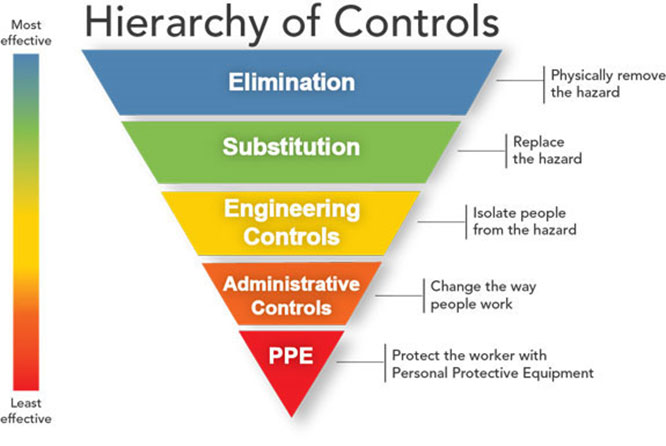
As the coronavirus, or COVID-19, pandemic continues to spread globally, healthcare systems have, as a result, become increasingly overwhelmed by an influx of potentially infected individuals seeking testing and care.
The reduction of infection risk and exposure from both the community, the patient channel, as well as from healthcare workers, overall, is most appropriately enforced through a “Hierarchy of Controls.” This model can be understood under all operational statuses, something the Center for Disease Control, or CDC, identifies within three levels. The first level being conventional; the second contingency; and the third, and current, being crisis.
First and foremost, as seen above, the totalized elimination of the physical hazard is preferred. Continuing downward, we eventually come to personal protective equipment, or PPE.
Within this, prevention relies upon the effective use of PPE, including, but not limited to: gloves, face masks, goggles, face shields, respirators, and gowns. However, due to the grand increase in communities seeking testing and care, PPE has become an incredibly limited resource for healthcare systems at large.
As such, during an operational crisis mode, all non-urgent and non-essential activities are put to a halt, as PPE is used significantly in outpatient appointments and so on. It is preferable, according to the CDC, to eliminate or greatly reduce the possibility of infection, and therein to allocate PPE resources appropriately, especially within areas of high demand and infection.
As a result, many healthcare systems are currently, or are in the process of, implementing solutions such as telehealth screenings and virtual visits in order to eliminate or mitigate risk of infection risk and exposure. Not only does the digitization and implementation of these procedures ensure a reduction in infectious risk and exposure, but allows for PPE to be appropriately distributed amongst struggling healthcare systems. This further reduces overall healthcare cost, including cost allocated to PPE.
With the utilization of telehealth services such as RelyMD, the average usage of PPE – regardless of held operational status – would therefore be minimized, both limiting resource consumption and allocating supplies in an efficient, cost-effective manner. Such measures are imperative to the future of healthcare.
RelyMD is a growing digital health company that provides a coordinated telehealth solution to health systems, managed care organizations, and employers. Founded by a group of innovative emergency medicine physicians and healthcare entrepreneurs, we’re on a mission to simplify people’s lives by delivering reliable, trusted medical care – anytime and anywhere – that fosters healthier communities and workplaces. Learn how RelyMD can help address PPE concerns for your patients and healthcare workers.
ADDITIONAL RESOURCES
Case Study
Health System Utilizes Virtual Urgent Care to Lower COVID-19 Exposures
Learn how RelyMD can help your organization
Let our telehealth expert show you how powerful virtual health can be.
Get in Touch
5665 NEW NORTHSIDE DR STE 320
Atlanta, GA, 30328
855-955-0948



